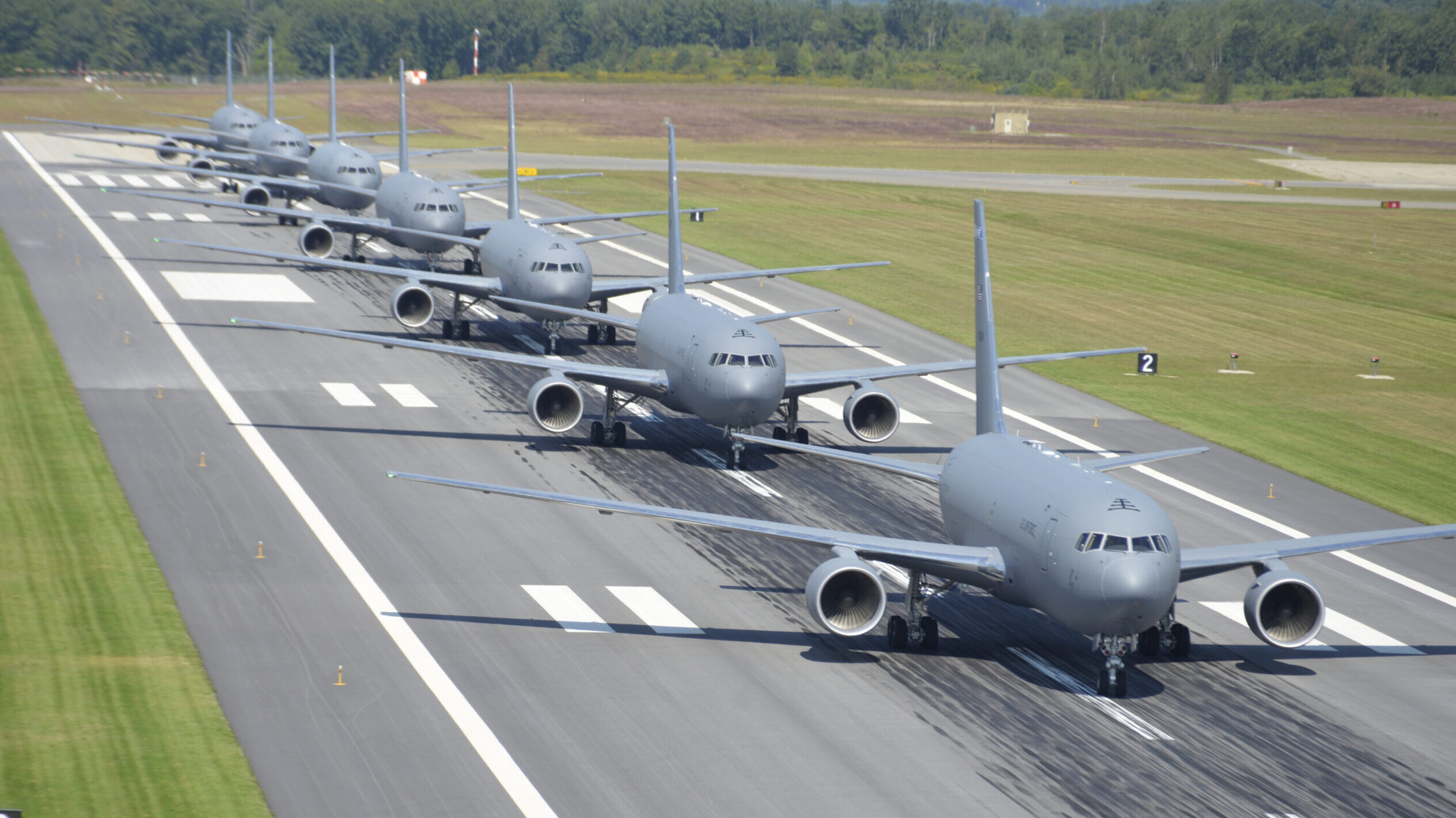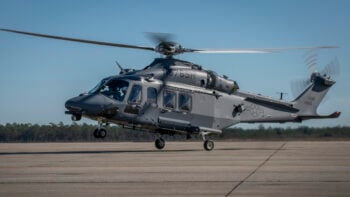
KC-46A aircraft assigned to the 157th Air Refueling Wing perform an elephant walk formation on the runway at Pease Air National Guard Base, Sept. 8, 2021. (U.S. Air National Guard/Senior Master Sgt. Timm Huffman)
WASHINGTON: The US Air Force is on the precipice of approving a new design for the Boeing KC-46 tanker’s troubled Remote Vision System, a suite of cameras and sensors that provides boom operators video imagery during aerial refueling.
But in a new report released today, the Government Accountability Office implores the service to take additional steps to ensure the redesigned “RVS 2.0” is mature and tests it an operational environment. Otherwise, it warns, the Air Force could end up with a massive bill or further delays to the fielding of the system, currently planned for 2024 at the earliest.
“Without taking these steps prior to closing the preliminary design review, the program may accept a remote vision system design that contains immature technologies and greater risk of cost and schedule growth,” the GAO states in its report.
“The sooner the program completes these steps, even if after the design review, the sooner it can identify design issues and proactively take steps to mitigate any further cost growth and delays in delivering promised capability to the warfighter.”
The Remote Vision System has been the source of a longstanding disagreement between the Air Force and Boeing, which is locked into a fixed-price contract where it is responsible for paying for any costs above the 2011 agreement’s $4.9 billion ceiling. (Boeing has logged about $5.4 billion in charges so far.)
The Air Force claimed that the RVS, as currently designed, did not consistently provide boom operators with clear imagery. In certain lighting conditions, the picture could be difficult to see or appear stretched, making it more difficult for boom operators to safely guide the boom into a receiver aircraft without scratching it.
In April 2020, Boeing agreed to redesign the system and assumed the costs associated with developing the new “RVS 2.0,” cutting it into the tanker’s production line, and retrofitting existing KC-46s. In return, the Air Force consented to pay for any design changes that the service hypothetically mandates after approving RVS 2.0’s preliminary design.
However, not all details concerning the RVS redesign have been settled.
In May 2021, Boeing presented the Air Force with its preliminary design for RVS 2.0, which includes new electro-optical and infrared cameras, along with a redesigned primary display that projects a 3D image from those cameras to the boom operator.
According to the GAO, Boeing officials described the technology readiness levels of those elements of RVS 2.0 as either at the TR 5 or TR 6 stage — basically, that components have been validated or prototypes demonstrated in a laboratory setting.
Meanwhile, GAO asserted that best practice is for a system to be at least TR 7 at its preliminary design review, or at a stage where a prototype has been demonstrated in an operational environment.
“We found all three critical technologies are immature based on best practices we identified,” the GAO stated. “Program officials also said they were not confident in Boeing’s assessment of TRLs for the critical technologies and that the TRLs may be overstated. Furthermore, while Boeing outlined some steps to mature the visible camera and primary display, it did not identify any steps for the [low wave infrared] boom camera.”
The GAO suggested that the Air Force independently assess the technology level of the new camera suite and primary display, and develop a plan to mature them if needed. The service should also integrate and test a prototype in an operational environment prior to the preliminary design review approval.
“The program, however, does not plan to test the RVS prototype on the KC-46 until 2023, during developmental testing, meaning it will take another 2 years to determine whether the integrated system works,” the report stated. “This increases the chances that the program discovers new deficiencies later than it could have, which is what happened during the development of the original RVS.”
Put plainly: After years of technical difficulties, the Air Force is going to simply trust Boeing’s self-assessment, rather than conduct its own evaluation to determine if the new system works or not. And if the service finds out in testing later down the road that the system isn’t what it wants, it will have to pay for design changes.
The Air Force, for its part, has held off on approving the RVS 2.0 design due to questions about the panoramic display system — a separate suite of cameras used to detect and identify aircraft approaching the tanker to get fuel — which service officials have also criticized for not meeting requirements.
Although a fix for the panoramic display system was not included in the terms of the April 2020 agreement on RVS, the Air Force is hesitant to approve the new RVS 2.0 design without having assurances that the panoramic display system will also be fixed to its satisfaction, a source with knowledge of the program told Breaking Defense earlier this month.
Delays and more delays
A total of seven critical deficiencies — including two related to the performance of the RVS and another where the stiffness of the boom keeps it from being able to refuel certain aircraft — have already pushed the KC-46 program years behind schedule.
To allow time to correct those issue, the Air Force delayed a full rate production decision for the program from October 2020 to September 2024. However, GAO notes, the schedule for developing and testing the redesigned boom and RVS 2.0 is extremely tight, with operational test and evaluation set to wrap up in May 2024 — mere months before the production decision.
At the same time, the Air Force is set to acquire anywhere from 12 to 15 tankers per year, which will eventually need to be retrofitted with the redesigned systems. GAO states that the Air Force will have procured at least 118 KC-46s by the end of fiscal 2024 — or about 67 percent of the 175 production aircraft planned over the program. (The Air Force plans to acquire a total 179 KC-46s, including four system development and demonstration aircraft.)
Further delays to the KC-46 schedule could be unavoidable.
Currently, the program expects to meet the “required assets available” milestone in March 2022 — already years late from the initial August 2017 date. This milestone involves the delivery of 18 KC-46s in their final production configuration, along with nine sets of aerial refueling pods and two spare engines.
But given the time it will take the Air Force to retrofit its first 18 tankers with the new boom and RVS systems, GAO estimates that the service will not be able to fulfill the RAA requirement until January 2026 — eight and a half years after it was supposed to happen.
Air Force declares ‘critical’ Nunn-McCurdy cost breach for MH-139A Grey Wolf helo
The cost breach is driven by the service’s plan to cut the buy of the helicopter in half, not by any cost overrun in the program itself.


























